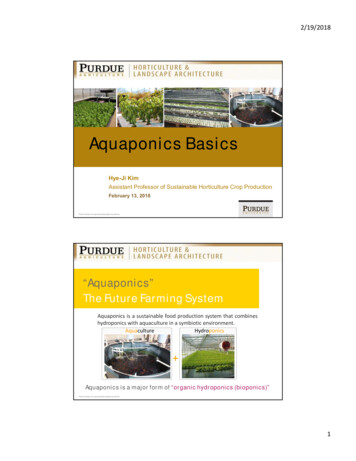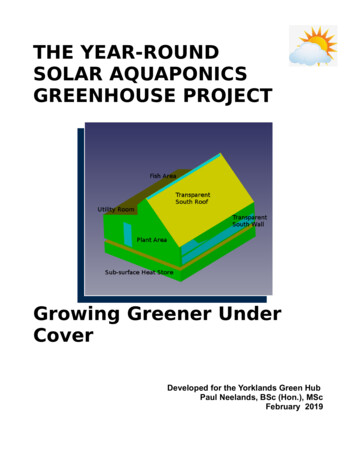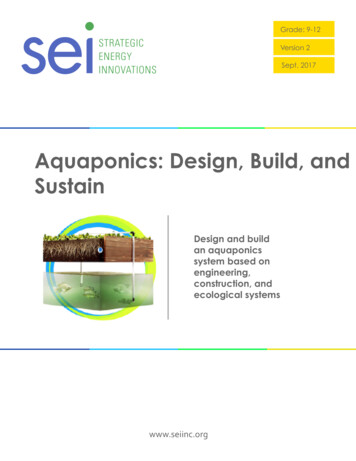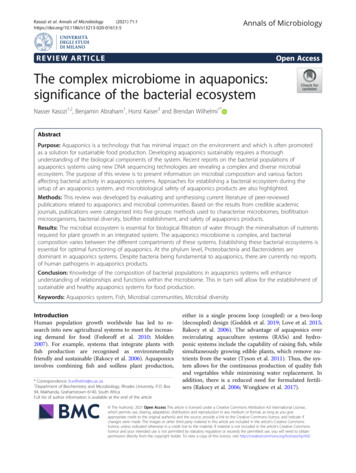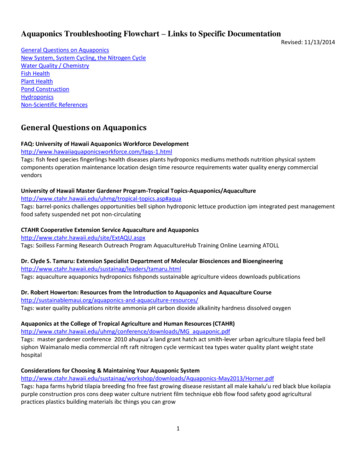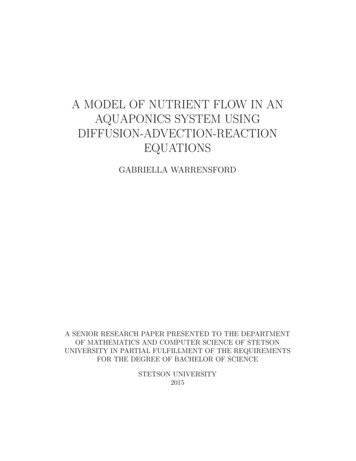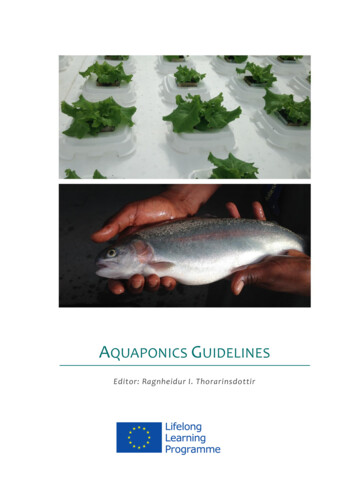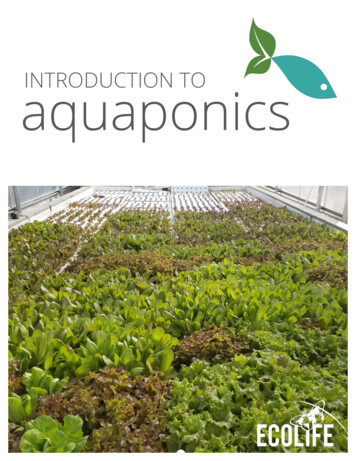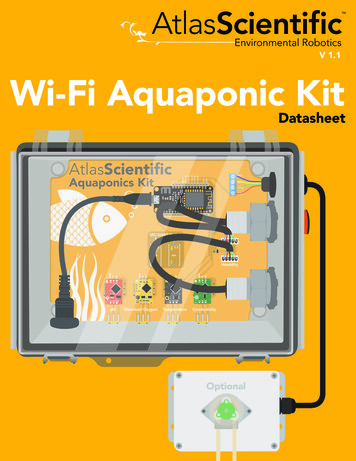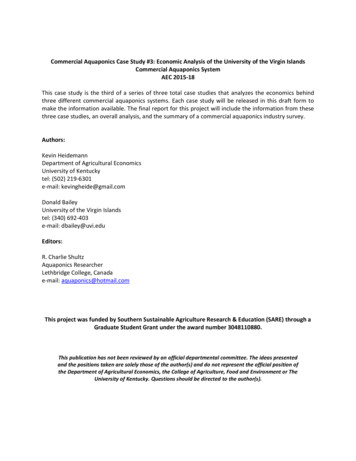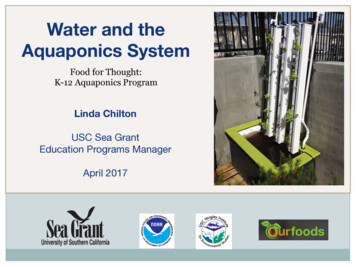
Transcription
Water and theAquaponics SystemFood for Thought:K-12 Aquaponics ProgramLinda ChiltonUSC Sea GrantEducation Programs ManagerApril 2017
Objectives of this lesson Reflect on the role water plays in supporting life on our planetand more specifically in food supply Learn the importance of preparing the water in your aquaponicssystem and how to monitor the health or quality of the water Begin to explore the flow of water in the system Begin to explore the relationship between water and food justice
Aztecs farmed“floating”islandsChinampastoday
Similar farming practices today rice fields fish birdsthat began as early as 6th century in Southern China
What do you notice is similar between thesethree systems?
Hydroponics –Large scale plantproduction with nutrientsolution and without soil
AquacultureLarge scale fish, crab, lobster, snail and clam farming
Aquaponics Aquaculture Hydroponics Aquaponics Aqua: from Latin for water ponics: from Greek, to work or labor; refers toroots growing in water, without soil
Aquaponics raise both animals and plants nutrients produced are usedby the system everything cycles less water, less power needed less expensive thenhydroponics creates natural nitrogenbalance
Why Do They Need Water? Plants Fish Pump Microbes
Water Circulation Using the large sheet of paper create a model of watercirculation in your tank. How does water move through thesystem? Remember to label all of the processes andinteractions.
Talk With Your Partner Discuss how you can decide which water to use toput into your system?¡Can you use water from the tap?¡From the hose?¡Do you need bottled water?¡Do you need special water?¡Can you use LA River water?
Talk With Your Partner How can you be certain the water is healthy for your aquaponicssystem and the life in your system? Clear water doesn’t always equal healthy water!
Water Test Kits Used to measure water quality – the health of the water. Thewater test kits use reagents that are added to the sample ofwater to find the levels of important parameters of:- dissolved oxygen- nitrite- nitrate- alkalinity- ammonia- temperature- pH
Dissolved Oxygen Oxygen is essential to support healthy fish, roots,and microbes. Dissolved oxygen is measured in parts per million(PPM) or milligrams/liter (mg/l). Oxygen levels changerapidly once a sample is taken from the system. Temperature, pressure and elevation all effect how muchoxygen can stay dissolved in water. Pumps and splashing water increase oxygen availability. Less oxygen stays dissolved in warmer waterhttp://www.teamorca.org/
pH (potential Hydrogen)Acidic amount of free hydrogen or free hydroxyl ions(how acidic or basic a solution is respectively).¡plants ability to absorb nutrients¡animal and microbe health The pH scale is 0 – 14 with 7 as neutral;¡Neutral pH impactsplants do better at a lower pH The amount of salts (softness or hardnessof the water) effects the stability the pH of thewater.Basic
Temperature Water temperature ranges for fish and microbes must bemonitored Different species of fish, have different temperature needsbased on their native ture)TroutTilapiaGoldfish55 – 65oF74 – 80oF65 – 75oF(38-68 F)(60-95 F)(45-90 F)
Temperature Temperature effects:¡¡the ability of bacteria to convertammonia to nitrates that can beused by plantsOxygen availability in waterfor fish, roots, microbes Time of day, heat of the room can both effect temperature. Most fish can handle wide temperature changes over severalhours but not rapid changes.
Measuring Nitrogen Nitrogen can be found in three forms in your system so wemeasure all three¡Ammonia – from fish wastes and decomposition; high levelscan be deadly to fish¡Nitrite – after bacteria convert the ammonia to nitrite; still aproblem for fish¡Nitrate – a form of nitrogen plants can use to grow and notharmful to fish in limited amounts
Changes in Water Quality What might change in your system from morning to afternoonthat would change water quality? What other clues can you use to tell the water quality ischanging, before you do a test? As we look how does this project effect the world in which welive, we are looking at an alternative to conventional farming.
Water & Food Production 70% of freshwater used goes to agriculture Roughly 30% of the food produced worldwide (about 1.3 billiontons) is lost or wasted every year, which means that thewater used to produce it is also wasted When we look at water on a world scale, water scarcity directlyimpacts food security Global food and nutritional security, requires producing morenutritious food with less water Aquaponics is one alternative to conventional farming that usessignificantly less water.
Questions?Thanks for a productive day!Linda ChiltonEducation Programs ManagerUSC Sea Grantlchilton@usc.edu
Aquaponics raise both animals and plants nutrients produced are used by the system everything cycles less water
